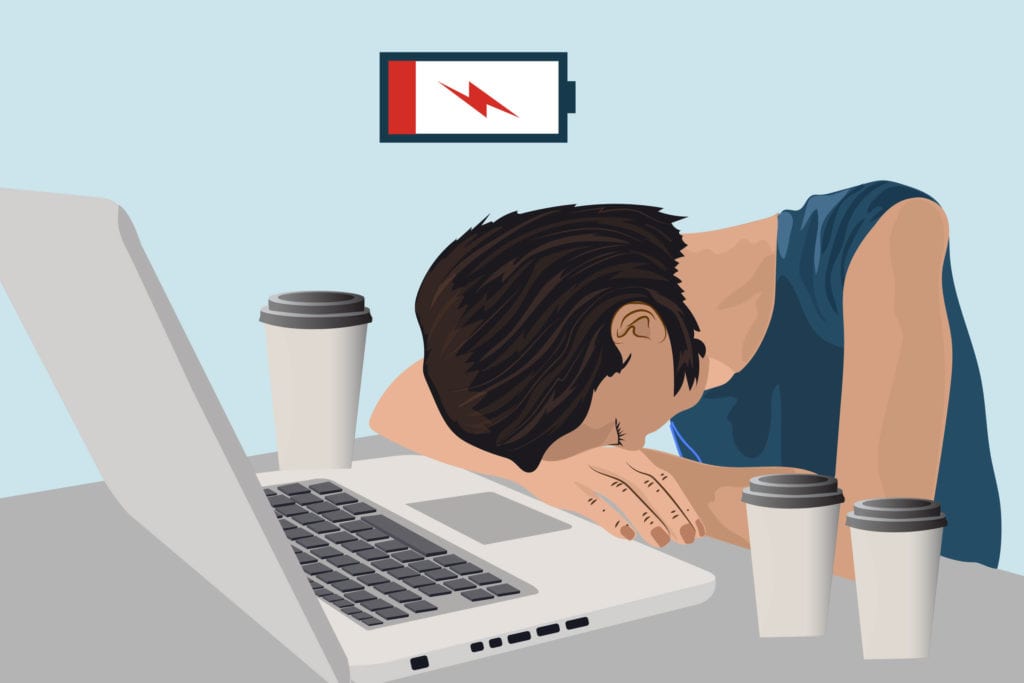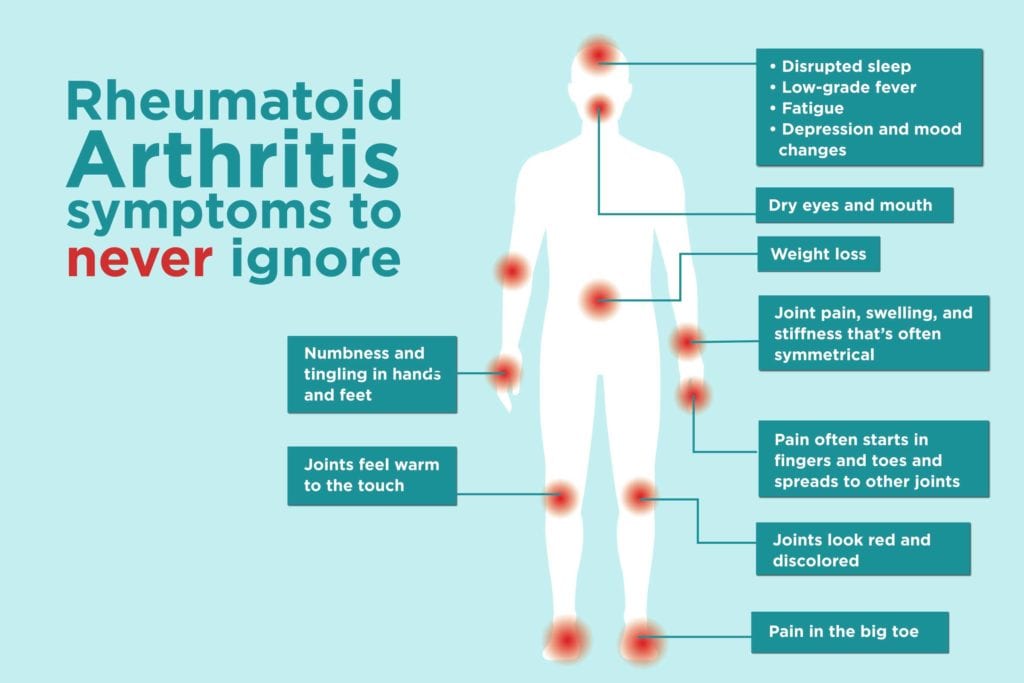Aches and pains are a common part of life at every age, and can occur for many reasons — an especially tough workout, too much snow shoveling, lifting something the wrong way, dancing too enthusiastically, or engaging in repetitive hand motions like typing or knitting.
But pain is also the most common symptom of rheumatoid arthritis (RA), a chronic, inflammatory disorder in which the body’s own immune system attacks the lining of the membranes that surround the joints. According to the American College of Rheumatology, RA is the most common type of autoimmune arthritis, affecting more than 1.3 million Americans — 75 percent of whom are women. The disease usually strikes first between the ages of 30 and 60.
The symptoms of RA may be obvious or not, and can sometimes mimic other diseases, especially in the early stages. The most common symptoms of RA — such as pain, swelling, and tenderness around the joints — tend to come on gradually. People may discount minor pains or morning achiness as just a sign of aging or indication of an overuse injury. It may take a while before someone suspects that RA is the cause of their discomfort. But rheumatoid arthritis has many other symptoms as well, and recognizing what they are can help patients get diagnosed and treated as early as possible, so they can prevent or minimize permanent damage to the joints, and lead active, less-painful lives.
“Rheumatoid arthritis presents in many ways,” says John M. Davis, III, MD, a rheumatologist at the Mayo Clinic in Rochester, Minnesota. “It can have episodic, chronic, or acute onset. Ultimately most patients develop joint pain and stiffness, but there is great variability in symptoms. Sometimes patients present with other organ involvement, such as eye, lung, or neurologic changes. Sometimes patients develop abnormal fatigue or fevers. The pattern of symptoms helps establish the diagnosis.”
While rheumatoid arthritis can affect each person differently, there are common symptoms that affect nearly all patients, as well as lesser-known symptoms that can also provide clues to diagnosis. Here are some RA symptoms you need to be aware of. Some are specific to the joints, while others are more systemic.

RA Symptoms That Directly Affect the Joints
Joint pain
“Persistent pain is what typically drives patients to see their doctor,” says Dr. Davis. The pain is the result of inflammation, which causes the joint to produce extra synovial (joint) fluid that then puts pressure on the capsule surrounding the joint and irritates the nerve endings. RA can affect a single area of the body or multiple areas, including the fingers, wrists, elbows, shoulders, hips, knees, ankles, toes and forefoot, neck, shoulders, and jaw. Usually the small joints, like the fingers and toes, are affected first. When there’s tenderness in the joints at the base of the toes, people may walk on their heels or lift their toes as they walk to avoid putting pressure on that area.
“Typically patients will have tried over-the-counter medication with very little relief,” says Vivian Bykerk, MD, a rheumatologist with the Hospital for Special Surgery in New York City. “It often feels like an intermittent, sharp pain that just doesn’t resolve.” And unlike some other types of pain, patients may feel the hurt whether the joints are moving or at rest.
Stiffness
A feeling of stiffness, especially after waking up in the morning or sitting for a while, is also a strong symptom of RA. Stiffness from rheumatoid arthritis can last for hours. “People can’t bend their joints, especially in the arms and legs. Or they can’t make a fist. They feel clumsy,” says Dr. Bykerk.
As with pain, the stiffness can be specific to one or more joints, or can be a general feeling of overall body stiffness. As the disease progresses, the stiffness can also affect ligaments and tendons, which makes it hard to bend and straighten joints like the wrist. Patients may lose range of motion.
Swelling
Inflammation and accumulation of synovial fluid combine to make joints puffy and tender. “When the feet are involved, people may find they can’t wear their dress shoes,” says Dr. Bykerk. “Gloves or rings don’t fit; watches are too tight.”
When pain, tenderness, swelling or stiffness last for six weeks or longer, it’s time to suspect RA.
Symmetry
Usually in RA, but not always, if there is pain felt in a joint on one side of the body it’s also felt in the same joint on the other side. But the degree of pain may be different on each side, and the disease may progress differently on each side, too. According to the Johns Hopkins Arthritis Center, in the early stage of RA, when only a few joints are affected, there may not be symmetry yet.
Red or discolored joints
The skin over joints affected by rheumatoid arthritis may look discolored. Swollen joints may appear reddish because inflammation has caused the capillaries to widen, making more blood to flow into the area.
Joints that feel warm to the touch
For the same reason that joints may look red or discolored — increased blood flow from capillaries widened because of inflammation — joints may also feel warm to the touch. This warmth may be present whether the skin is discolored or not.
Numbness and tingling in hands or feet
These feelings can be an early sign of RA as inflammation in the joints causes nerve compression and loss of sensation.
Nodules
These noticeable lumps may appear under the skin near affected joints — often on the hands, elbows, forearms or knees. They can also affect other pressure points like the back of the head, the base of the spine, and the Achilles tendon. Usually not painful, in most cases rheumatic nodules move easily when touched. These bumps usually occur in more advanced RA or RA that has not been treated. Read more about rheumatoid nodules here.

Non-Joint Symptoms of Rheumatoid Arthritis
Fatigue
Feeling more tired than usual may occur even before other rheumatoid arthritis symptoms, like joint pain, are obvious. “Patients feel exhausted,” says Dr. Bykerk. “They get up, get dressed, and want to go straight back to bed.” The fatigue is a result of the systemic inflammation, and can affect people’s work life, sex drive, and everyday activities.
Disrupted sleep
Another reason for the ongoing fatigue may be difficulty sleeping as a result of RA pain. When inflammation affects the nerves within the joints they can become tender to the touch, making even slight pressure on that part of the body painful. The pain can make it difficult for someone to get comfortable in bed, or difficult to stay asleep, since any movement — such as turning over during the night — can hurt enough to interrupt sleep. (Many patients have a name for trouble sleeping due to pain: painsomnia. Read more about tips for coping with painsomnia here.)
Low-grade fever and malaise
A low but chronic fever — 99 to 100 degrees Fahrenheit — is another symptom of RA, as are general feelings of achiness, illness, or simply feeling unwell. It can feel like a mild flu that’s not getting better. Along with fatigue, these symptoms can mimic other conditions such as chronic fatigue syndrome or fibromyalgia.
Difficulty with daily tasks
The combination of joint pain, stiffness, and fatigue can make it difficult to carry on daily activities, and the loss of function can be extremely frustrating. “Especially when the hands are affected, it’s hard to hold a toothbrush, do up buttons or a zipper, open a water bottle, type on a keyboard,” says Dr. Bykerk. “It can even be difficult to hold a grocery bag… or a child.” Not being able to function normally and deal with daily life understandably sends many people to the doctor to find out what’s wrong.
Weight loss
Another consequence of fever, fatigue, and pain may be a loss of appetite, which can lead to weight loss. Any time you experience notable weight loss without trying to eat healthier or exercise more, it’s a red flag you should talk about with your doctor.
Dry eyes and mouth
According to the Mayo Clinic, about 40 percent of people who have RA also experience symptoms that involve other parts of the body in addition to the joints. For instance, people with RA may develop the dry eyes and mouth characteristic of Sjogren’s syndrome. Your eyes may feel gritty, as if sand has blown in. Lack of saliva may make swallowing difficult.
Other areas of the body that may be affected by RA include the skin, lungs, heart, kidneys, nerve tissue, bone marrow, and blood vessels. An experienced rheumatologist can put all the pieces together in order to diagnose RA as the underlying cause of the various symptoms.
Depression and mood changes
According to the Mayo Clinic, RA and depression commonly occur together. Doctors don’t know whether depression and anxiety in people with RA are a result of the physical symptoms, or if depression is itself a symptom caused by the chronic, systemic inflammation of the disease. But doctors do know that if the depression isn’t addressed and treated, the treatment for the arthritis can be less effective.
If you suspect your symptoms could be rheumatoid arthritis, you should get to a doctor promptly. Your primary care doctor is usually a good place to start. If they suspect RA or a related disease, they may refer you to a rheumatologist for further testing. A rheumatologist is a specialist who treats musculoskeletal and certain autoimmune or inflammatory conditions.
Keep Reading
If you enjoyed reading this article, you’ll love what our video has to offer.






